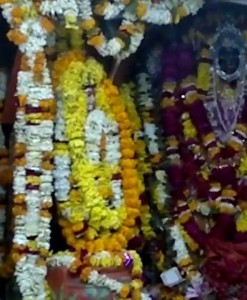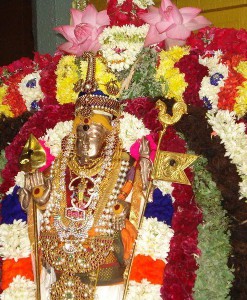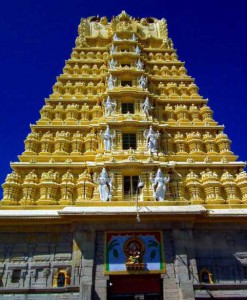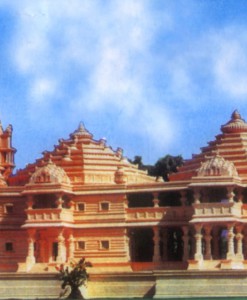No products in the cart.
Mahalaxmi Temple Mumbai
Mahalaxmi Temple Mumbai is an ancient temple dedicated to honor ‘Goddess Mahalakshmi’ who is also known as the ‘Goddess of Wealth’. This beautiful temple is situated at the North of the Malbar Hill, Bhulabhai Desai Road in Mahalakshmi area of Mumbai and was constructed in 1785. Visitors find the ambiance, ideal for offering their prayers to God. Three deities reside in the Mahalaxmi Temple Mumbai Complex, namely Kali, Saraswati and Laxmi. However, the principal deity is Goddess Laxmi, the temple is named after her.
According to ‘Sankhya Darshan’ of Hindu Philosophy the creation of our Universe is result of coming together of ‘Purusha and Prakruti’. Purusha is the ‘Parabrahmah’ and Prakruti is the ‘Nature’. Prakruti is ‘Trigunatmak’, that is it consists of three ‘Gunas’ – Sattvic, Rajasic and Tamasic depicted by three deities, Shree Saraswati depicting ‘Sattvic Guna’, Shree Mahalakshmi depicting ‘Rajas Guna’ and Shree Mahakali depicting ‘Tamas Guna’. Shreemad Bhagvad Gita is based on this ‘Sankha Philosophy’. This great power of all powers is conceived of by the devout worshipper in different forms in her three Avatars
It is believed that the Hindus immersed the three idols of the Goddesses into the sea near Worli creek to avoid destruction of the idols by the Muslim invaders. Subsequently, during British Rule, Lord Horneby decided to connect the two islands viz. Worli-Malbar Hill creek and the work was entrusted to Shri Ramji Shivji Prabhu, a Govt. Engineer who tried through his other engineers and technicians to link the two islands(creeks). They were not in a position to connect two islands by constructing two ways and could not complete the project on account of Sea – Waves. One night Shree Mahalaxmi Goddess instructed him in a dream and asked him to take out all the idols which were in creek of Worli and place them on top of the hillock. He promised the Goddess that he will take them out from sea/creek and place them in a temple on top of the hillock. Accordingly, team working for construction of connecting of Worli creek and Malbar Hill creek took out all the three idols of matajis from the Worli creek. Then only he succeeded to connect the said two creeks. After completion of this work, Engineer obtained ground on the hillock as a gift from the English Ruler. He then constructed a Mahalaxmi Temple on the said on top of the hillock by spending Rs.80,000/-. As per the records available this temple was constructed between 1761 A.D.1771 A.D.
Navaratri and Diwali are the special events that are celebrated at Shree Mahalaxmi Temple Mumbai – ‘Chaitra Navaratra’ in the month of Chaitra i.e. between March-April and ‘Ashwin Navaratra’ in the month Ashwin between September –October and Diwali during October – November. During Navaratra, the temple is decorated from the entrance to gabhara. Entire temple surrounding is decorated with various series of lights, flowers, garlands etc.

Navratra (nine nights) festival is celebrated for ten days during the Hindu months of Ashwin (around October). The daily routine of the temple is modified during this period. At 8.30 a.m. and 11.30 a.m. Abhishek is performed followed by Mahanaivedya and Aarti. Later at 2.00 p.m. the deity is decorated with all the ornaments. On all ten days at 9.30 p.m. the litter of the Goddess is decorated in different forms with flowers and lights and is taken out in procession in the temple complex. Government sponsored police and military band is played at the head of the procession. The event culminates at 10.30 p.m. when the litter returns to the Garud Mandap and is placed on a special pedestal. The Goddess then receives one canon salute. Various cultural programmes are organized by the Mahalaxmi Temple Trust in these ten days. At the time of Navaratri celebrations, devotees from distant places visit the Mahalaxmi Temple to witness the glorious festive celebrations. They have to stand for hours in long queues holding coconuts, flowers and sweets which they offer to the goddess. During three to four days of Diwali including ‘Laxmipoojan’ there is heavy rush of devotees.
Annakut which is held on the day of Kartik Pournima, celebrated in this temple after the Diwali festival when 56 types of various sweets and food items etc. are offered to matajis as naivedya and then the said items are distributed to all the devotees and more than 500 devotees avail of benefit of Prasad /dinner on Annakut day.
Margashirsh month: During recent years there is more rush of ladies on the occasion of Margshirsh month (i.e.During December and January). There is tremendous rush like Navaratra in the temple. This month is considered very auspicious when devotees offer their prayers sitting in front of Sabha Mandap.
Palkhi of Mataji Palkhi procession takes place on ‘Gudhi Padwa’, i.e. 1st day of the Marathi New year in the month Chaitra (March/April). Chaitra Navratra starts on 1st day of Chaitra. Palkhi procession takes place on 17th June every year being the anniversary day of the ‘Dhwjasthambha’ which was erected in front of the temple near deepsthambha. Dhwjasthambha was dedicated at the hands of Jayendra Saraswati Shankaracharya of Kanchi Kamkoti. During palkhi procession lot of devotees take part and pray to the Goddesses for choicest blessings.
Rathotsav
Rathotsav (chariot festival) is organized in April. The chariot bearing the silver representation of the Goddess is decorated with flowers and lights. It is taken out in a procession in the evening from 7.30 p.m. to 9.30 p.m. The devotees can pay their respects to the Goddess when the procession arrives at the main entrance of the temple. At 9.30 p.m. one canon salute is given to the Goddess and the procession is taken outside the temple. It moves in the city and returns to the temple. The procession is accompanied by military or police band. Huge Rangoli (floor paintings) are drawn along the path of the procession and fireworks add to the festivities. Several devotees flock to participate in this event.
Kirnotsav
Kirnotsav (festival of Sun rays) is celebrated when the sun rays fall directly on the deity’s idol at the time of sunset on the following days:
31st January & 9th November: Sun rays fall directly on the feet of the deity.
1st February & 10th November: Sun rays fall directly on the chest of the deity.
2nd February & 11th November: Sun rays fall directly on the entire body of the deity
Special Rituals/ Prarthana performed in temple
The three idols, Shri Mahalakshmi, Shree Mahakali and Shree Mahasaraswati are bathed daily and dressed in Saree and heavy ornaments like nose rings, gold bangles and pearl necklaces. The idols are then decorated with flowers, tika, fruits, prasad and various offerings followed by the morning prayers.
Present Timings of Temple and Aarti Schedule
Opening Time: 6.00 a.m.
Aarti Schedule: Morning – 7a.m. to 7.20 am (Main arati)
Naivedya: 12.00 noon
Evening: 6.30 p.m. to 6.40p.m. (Dhoop Arati – depending on timings of Sunset)
7.30 p.m. to 7.50p.m. (Main Arati)
Night: 10.00 p.m. (Shejarati – at the time of closure)
Mahalaxmi Temple Mumbai By Rail
The Mahalaxmi Station is the closest station to the temple and one can hire an auto-rickshaw or a taxi from here to the Mahalaxmi temple. There are two more temples viz. Tryambakeshwar temple and Mahadev dhakleshwar temple near to the temple
Mahalaxmi Temple Mumbai By Road
Mahalaxmi Temple is well-connected by roads therefore it is easy to reach the temple via road. Buses are available from the Mahalaxmi Station to the Mahalaxmi Temple. One can also drive through NH-4 to reach the temple.
Mahalaxmi Temple Mumbai By Air
The city of Mumbai is a most important international doorway to India with international flights from major countries of the world. Air India and many other global air carriers operate regular flights to and via the city. Indian Airlines connects the city of Mumbai with nearly all tourist destinations of India. Private sector airlines also offer air-link to many key centres of the country. The Mumbai airport has two wings which are Chhatrapati Shivaji international Airport and Santacruz domestic airport.









